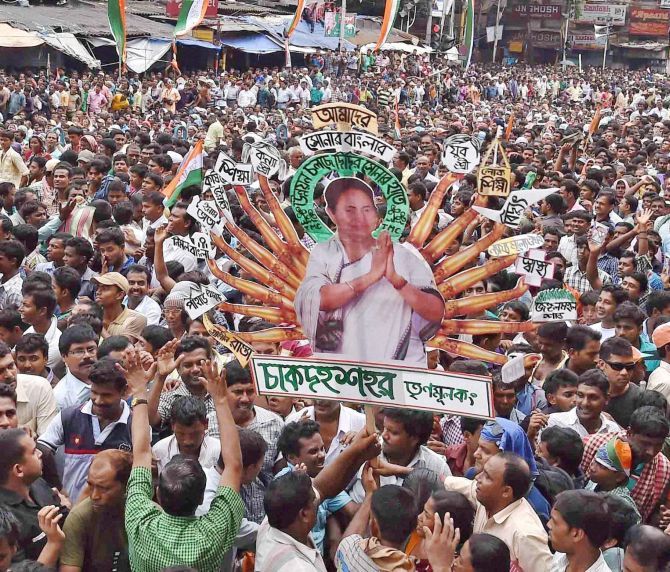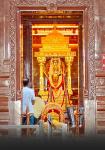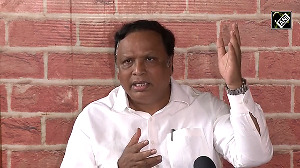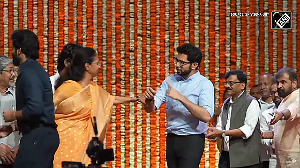'Usually, the Left backed the Congress and other 'secular' parties on the justification of keeping the BJP out. In Bengal, the alliance targets a truly secular rival,' says Shekhar Gupta.
 You sure can read the writings on the wall travelling through poll-bound West Bengal even if you don't know a word of Bangla. Because the writings on the political wall are now written not only in unusual scripts but also in unique inks.
You sure can read the writings on the wall travelling through poll-bound West Bengal even if you don't know a word of Bangla. Because the writings on the political wall are now written not only in unusual scripts but also in unique inks.
They are written in millions of tiny LED lights strung on electricity poles on Kolkata's avenues, in vinyl and cloth in the flags of the three main parties, happily sharing the same tree, rooftop, even clotheslines. And yes, some also in conventional ink on newsprint.
In different scripts, these describe a political change so complex and dramatic, only 93 million Bengalis could have scripted it.
They enabled Mamata Banerjee (her party leaders prefer the traditional Bandopadhyaya) on the promise of poriborton (change) to throw out the Left. Five years later, they have to decide whether they believe the promised change came.
The LED lights tell us the one thing that hasn't changed is the megalomania of power.
The Left only filled the city with red flags and defaced its walls with party slogans and giant hammer-and-sickles; Ms Banerjee's Trinamool Congress has painted the entire capital blue and white in the political colours of her party.
In daytime, it is somewhat less pronounced, with blocks of apartments painted blue-and-white, incentivised by the government. But it is much more striking by night, as you drive down avenues flanked and divided by strings of lights in the same political colours. I ventured out for my usual late-night walk and, after a few hundred metres, was lost in a sea of blue and white.
The Left also perfected winner-takes-all politics but did not have a personality cult. The TMC's is an entirely personality-centric government and politics, with its senior-most leaders referring to their leader as 'supremo.' a description I first heard in Indian politics from Jaya Prada in the Andhra election campaign of 1993 and which, since then, has defined the politics of some of our states, notably Tamil Nadu (J Jayalalithaa) and Uttar Pradesh (Mayawati). Bengal is the third.
Shifting from the cult of a cadre-based party to a supremo-led one has not softened the metaphor and tone of politics or rival campaigns, as characterised by Ms Banerjee's 'Aikta, aikta hishab nebo (I will settle scores with you, one by one)' warning to her rivals. But the usually violent edges of street politics have been blunted and that is an enormous transformation.
That is what the writings in cloth and vinyl tell us. At first sighting, I was taken aback seeing CPI-M and Congress flags on the same trees and homes. This would have been inconceivable in the past. In fact, you can be sure a Congressman putting his flag on a CPI-M home or vice versa would have led to a bloody fight.
State Finance Minister Amit Mitra, whom the world knows as a fine economist, tells me between 1972 and 2009 nearly 57,000 persons had been killed in political violence. "Come to my constituency," he says, "I shall walk you past shahid vedis (martyrs' memorials)." One is for a CPI-M man killed by the Congress, the other for a Congressman killed by the CPI-M and so on, he says, wondering how their alliance would work. But it may just, if even in contentious Singur flags of the TMC are also sharing the same spaces.
This is so significant in a state where parties routinely staked out entire walls if not neighbourhoods with 'this wall reserved for so-and-so' graffiti months before elections. Any transgression of such a line of control would invite brutal retribution. Now, if they all share the same spaces, it tells you two things.
One that Bengal's politics has become just a little less violent (this campaign so far has 'only' recorded one death, as Ms Banerjee proudly tells us). And second, that following five years without a friendly police, the CPI-M has had to give up its politics of dadagiri.
After his joint rally with state Congress chief Adhir Ranjan Chowdhury, CPI-M leader and the man widely seen to be chief minister if the anti-Mamata front wins, Surjya Kanta Mishra fields questions on what lessons his party has learnt, with un-CPI-M-like calm.
"It was wrong to let party cadres get involved in governance," he says, and promises to immunise the bureaucracy from party-men now.
Many still don't believe this promise will be kept, or even that the alliance will last much longer. "For decades, we have seen them kill each other. Now they've joined hands only to get her out," says a businessman who'd rather stay anonymous, "but presuming this objective is achieved, what will keep them together?"
Amit Mitra talks about the man whose hands were chopped off by CPI-M thugs for the "crime of voting for the Hand symbol of the Congress." How can these two parties join hands now?
That supposed inevitability of a break-up is, however, not written on the political walls of Bengal in 2016. The CPI-M knows another spell in the wilderness would destroy them, and the Congress is already marginal. So the two have a compulsion to stay together. They may not have a joint manifesto, but you can see the CPI-M stepping back from its more doctrinaire political economics -- that, its leaders now confess, made them go into decline 2008 on.
This, for India's political Left, is a tectonic shift.
Usually, the Left backed the Congress and other 'secular' parties on the justification of keeping the BJP out. In Bengal, the alliance targets a truly secular rival, even if Ms Banerjee comically overdoes it by ending her speeches with 'Namaste, goodbye, Sat Sri Akal, Vanakkam, Khuda Hafiz' and, finally, 'Inshallah.'
This is a purely political alliance against another formidable left-secular force.
Given that conservative V S Achuthanandan still leads the party in Kerala, mine may be a leap of faith. But let's risk saying that we see a firm shift by the Indian Left from doctrinal purity to political realism, from Communism to a social-democratic, centre-left approach without dadagiri.
It has worked beautifully for them in India's other Bengali-speaking state, Tripura, under Manik Sarkar.
Sometime in 1988, I came to Bengal to report my first political story here. When Mikhail Gorbachev and Deng Xiaoping were reforming, why were India's Communists resisting change? The story I wrote features the then party chief in Bengal, Saroj Mukherjee, sitting in his office under portraits of Marx, Lenin and Stalin and proudly saying: 'Because our Communism is purer than that of Deng and Gorbachev.'
That phase, I dare say, is over -- I recall an admonition I once got from Pranab Mukherjee when my paper, and I, were relentlessly attacking the Left for hobbling Manmohan Singh. 'Learn from political history,' he said, 'India's Left is not unchanging. At Independence they rejected democracy, now most of them fight elections. More change will come, give them time,' he had said.
We also talked about writings on the wall scripted also in conventional ink on touchy-freely newsprint. Check out the leading Bengal papers from Aveek Sarkar's Ananda Bazar Patrika Group. Not since some Ramnath Goenka years at The Indian Express have you seen a publishing group take such a partisan stand in an election.
Ms Banerjee and her party impute a dozen ugly motives to Mr Sarkar's turn. But India's doughtiest newspaper baron today (and nuttiest, to take on Mamata Banerjee and Narendra Modi at the same time) has read something that you may miss at first glance on his state's political walls. It is written across the front page of his paper, in the headline 'Hand in Hand.'
Each 'hand' is stylised in the colours of the CPI-M and the Congress, respectively. It tells you of a centre-ward shift of India's Left as much as the Congress leaning to the left under Rahul Gandhi.
That realignment is the big political message of this Bengal election.












